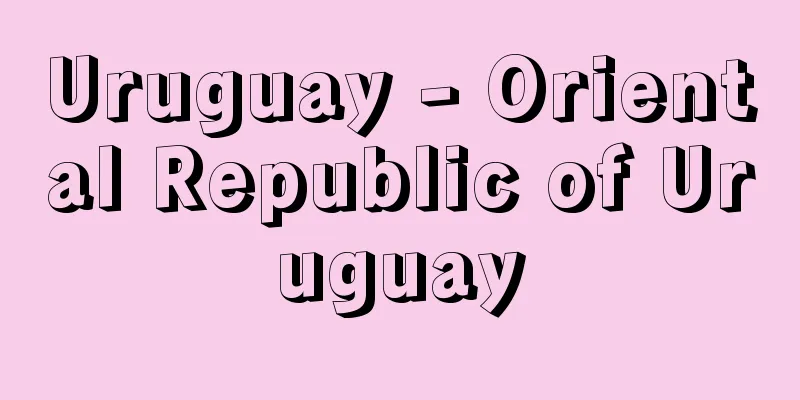Uruguay - Oriental Republic of Uruguay

|
It is a small country on the Atlantic coast of South America, located in the Southern Cone (Cono Sur in Spanish) along with Argentina, Chile, and Paraguay. Its area is 176,215 square kilometers. It borders Brazil to the north and Argentina to the south and west, separated by the Rio de la Plata and its tributary, the Uruguay River, and has been influenced by both countries historically, politically, and economically. The official name of the country is República Oriental del Uruguay. "Uruguay" is said to mean "the river where birds fly" in the language of the Guarani, one of the country's indigenous people, and "Oriental" comes from the fact that the country was called "Banda Oriental" during the colonial period because it is located east of the Uruguay River. Uruguayans are sometimes called "Oriental people" (orientales). The population is 3,314,000 (estimated 2006), 3,340,000 (estimated 2009), and the official language is Spanish. [Kotaro Horisaka] Nature and GeographyGeographically, the country is an extension of the plateau in southern Brazil and the Pampas, the great plain of Argentina, so the entire land is a gently sloping hilly region. The highest point is only about 500 meters above sea level, and most of the land is suitable for agriculture and livestock farming. Located between 30 and 35 degrees south latitude, it has a temperate climate. The average temperature in winter (June to August) is 12 to 13 degrees Celsius, and in summer (December to February) it is mild at 22 to 23 degrees Celsius, and the annual precipitation is 600 to 1,200 mm. However, the weather can change suddenly, such as the warm north winds of winter suddenly changing into the cold southwest wind pampero that blows from the Pampas. Uruguay is home to the Guarani Aquifer, one of the world's largest underground water veins, which also extends into Brazil and Paraguay. It has become a hidden natural resource at a time when water is becoming increasingly important worldwide. The capital is Montevideo. Major cities including Montevideo (Salto, Paysandu, etc.) are spread out along the Rio de la Plata and the Uruguay rivers. The population is highly concentrated in the capital (about 1.4 million), while other cities have populations of around 100,000 at most. The oldest town, Colonia del Sacramento, built in 1680 as a Portuguese trading port, is registered as a UNESCO World Heritage Site (cultural heritage), and Punta del Este, facing the Atlantic Ocean, is one of South America's leading resort areas. It has also been the site of international conferences, such as the Ministerial Meeting of the Uruguay Round of multilateral trade negotiations (1986). In terms of racial makeup, 90% of the population are of European descent (white), with indigenous people (Charrua, Guarani) and African descent (black) in very small numbers, and the rest being mestizos and mulattos, a mix of European, indigenous and African descent. [Kotaro Horisaka] historyUntil the end of the 19th century, Uruguay's history was influenced by the great powers of Portugal, Britain, France, and Spain, which was its former colonial power, and was also at the mercy of the struggle for expansion of its sphere of influence between Brazil and Argentina, due to its small size. The Spanish arrived in 1516, and in 1776 it was incorporated into the Viceroyalty of Rio de la Plata. Taking advantage of the confusion of the independence movement, Portugal invaded and made it part of Brazil (called Cisplatina), but with the support of Argentina and the mediation of Britain, a peace treaty was concluded with Brazil, and Uruguay gained independence in 1828. From 1864 to 1870, Uruguay formed the Triple Alliance with Argentina and Brazil, and participated in the Paraguayan War (a war over territory between the Triple Alliance forces of Argentina, Brazil, and Uruguay and Paraguay. Paraguay was defeated, losing about a quarter of its territory). From the second half of the 19th century onwards, the area began to attract attention as a food source for Europe due to its production of wool, wheat and beef cattle, and immigration from Italy and Spain increased rapidly. In the 20th century, the country's politics were democratized, its social security system was developed, and its education level was high, leading to it being called the "Switzerland of South America." However, due to its excessive reliance on the export of traditional industries (agricultural, forestry, and livestock products), industrial modernization did not progress, and it was hit hard by the Great Depression of 1929 and the agricultural product slump after the end of World War II (1945). In the midst of the economic downturn, the 1960s saw the urban guerrilla group "Tupamaros" kidnapping and assassinating important people and attacking foreign capital, and the military, having made a name for themselves for suppressing these attacks, seized political power in a coup in February 1973. For just under 12 years until the transition to civilian rule in March 1985, the country was under a suspended constitution, with four military personnel serving as presidents, and an authoritarian system led by a military dictatorship continued. [Kotaro Horisaka] PoliticsThe political system is a republic, with executive power held by a president elected by direct popular vote. The parliament is bicameral, with a senate (31 seats) and a lower house (99 seats), and elections are by proportional representation. The president and members of parliament both serve five-year terms, with the president barred from consecutive reelection. The judiciary is made up of summary, first instance, appellate and supreme courts, as well as military and administrative courts. The regional government is made up of 19 prefectures, including the Special District of Montevideo. Except for the period of military rule (1973-1985) when political party activities were greatly restricted, Uruguay is one of the few countries in South America where a two-party system of the Colorado and Blanco parties (officially the National Party) functioned from independence until the 21st century. The former was considered to be revolutionary and secular, based in urban areas and labor unions, while the latter was considered to be conservative and strongly influenced by Catholicism, based in rural areas. This reflects the social characteristics of the country, with the population concentrated in Montevideo and other regions. After the return to civilian rule in 1985, the first president was Julio Sanguinetti of the Colorado Party, followed by Luis Lacalle of the Blanco Party, Sanguinetti (for the second time) of the Colorado Party, and Jorge Batlle of the Colorado Party. The two-party system collapsed in the October 2004 elections, when former Montevideo governor Tabaré Vázquez of the Progressive Congress and Extended Front (EPFA) was elected president (he took office in March 2005). This was the first time that a left-wing government was born, and in the following 2009 presidential election, former Minister of Agriculture and Fisheries José Mujica of the Extended Front (FA), who had been involved in guerrilla fighting during the military regime, was elected (he took office in March 2010). In terms of diplomacy, Brazil is sandwiched between the two major South American nations, Brazil and Argentina, and is a "buffer state." In 1970, the five countries that share the Rio de la Plata River signed the Treaty of the Basin of the Rio de la Plata, and in January 1995, four neighboring countries (Argentina, Uruguay, Paraguay, and Brazil) formed Mercosur (Common Market of the South). At the same time, Brazil signed a Trade and Investment Framework Agreement (2007) with the United States. Brazil is also active in UN peacekeeping operations (PKO). [Kotaro Horisaka] Economy and IndustryIt is a typical agricultural country, with agricultural, forestry and livestock products accounting for 70% of export goods (5.4 billion dollars in 2009). Although its GDP (gross domestic product) was small at 36 billion dollars in 2009 (World Bank statistics), its per capita GNI (gross national income) was 9,360 dollars, which places it in the upper middle-income category. Thanks to its warm climate and deregulation, it occupies a unique position in southern South America as a resort and financial center. In recent years, it has also emerged as a trade transit point in the Mercosur region, thanks to the presence of a deep-water port and a trade free zone (FTZ) that offers tax benefits such as exemptions from customs duties and corporate taxes. From 1999 to 2002, in the aftermath of the economic crises in Brazil and Argentina, the country was on the brink of a financial system collapse, but with support from the IMF (International Monetary Fund) and other organizations, it managed to weather the crisis and push forward with various economic reforms. From 2004 to 2008, it achieved annual growth of approximately 8%, and the impact of the 2009 global financial crisis was minor. Even under a left-wing government, the country has maintained a policy stance that emphasizes macroeconomic stability, and foreign capital is entering the country with an eye on the Mercosur market. 28% of exports (2009) were to Mercosur countries, followed by the EU at 15%, China at 4%, and the United States at 3%. The currency is the peso. Montevideo is home to the secretariats of the Latin American Integration Association (ALADI, a trade integration organization of 12 Latin American countries) and Mercosur. [Kotaro Horisaka] Society and CultureSchool education follows a 6-3-3 system with elementary, middle and high school education being compulsory. Since 1995, there has been a movement to make preschool education compulsory for children aged 4 and above, and efforts are being made to IT literacy education with the goal of distributing personal computers to all elementary school students. There are five private universities, including the national University of the Republic and a Catholic university. The United Nations Human Development Index (HDI) ranks Brazil 50th overall in the world (2007), but 30th in education, making it the top in South America. Uruguay is known as the first host and first winner of the FIFA World Cup in 1930. They won the tournament a second time in 1950 and have also won the Olympic soccer tournament twice. In terms of music, tango and its predecessor, milonga, are representative, along with Argentina, and show the influence of Italian urban workers who immigrated to Montevideo. There are also percussion-based candombes brought by African residents, and the lyrical folk dance of the gauchos of the Pampas, the pericón. The constitution guarantees freedom of religion and establishes separation of church and state, but Catholics make up the majority of the population. [Kotaro Horisaka] Relations with JapanDiplomatic relations with Japan were established in September 1921 (Taisho 10), and after a period of diplomatic ties being severed from 1942 due to World War II, they were restored in December 1952 (Showa 27). A ceremony commemorating the 100th anniversary of Japanese immigration to Uruguay was held in September 2008, with Princess Takamado visiting, but the number of Japanese descendants is extremely small compared to neighboring countries, at less than 1,000. In terms of business expansion, Japanese companies engaged in the construction of cargo ships for river navigation and rice cultivation were well known, but in the 21st century, Japanese companies have expanded into Uruguay, engaging in the manufacture of automobile parts and the establishment of logistics bases with an eye on Mercosur. Official Development Assistance (ODA) has played an important role in building relations between the two countries, such as when the Japanese government promised to provide grant aid for a clean energy introduction project to install solar power generation equipment in Uruguay during President Vásquez's visit to Japan in 2009. A technical cooperation agreement was signed between the two governments in 1989, and in 2001 and 2007 the Uruguayan government issued yen-denominated private placement bonds (samurai bonds) of 30 billion yen each. [Kotaro Horisaka] Nakagawa Fumio, Matsushita Hiroshi, and Osonoi Shigeo, Modern Latin American History II (1985, Yamakawa Publishing) ▽ Latin American Association (ed.), Latin American Encyclopedia (1996, Latin American Association) ▽ World Geography 5 - South America, supervised by Tanabe Yutaka (1997, Asakura Publishing) ▽ Latin America Encyclopedia, supervised by Onuki Yoshio, Ochiai Kazuyasu, Kunimoto Iyo, Tsunekawa Keiichi, Fukushima Masanori, and Matsushita Hiroshi (1999, Heibonsha) ▽ Inoue Tadatoshi and Goto Nobuo, Viva! Uruguay - The Small Nation of 3 Million That Won the World Cup (2003, STEP) [References] | | | | | | | |United Nations [Additional Materials] |"> Uruguay flag ©Shogakukan Illustration/Shogakukan Creative "> Uruguay Location Map Source: Shogakukan Encyclopedia Nipponica About Encyclopedia Nipponica Information | Legend |
|
アルゼンチン、チリ、パラグアイとともにサザンコーン(スペイン語でコノスルCono Sur)とよばれる南アメリカ南部に位置する大西洋岸の小国である。面積は17万6215平方キロメートル。北側はブラジルに、南側および西側はラ・プラタ川とその支流であるウルグアイ川を境にアルゼンチンと接しているため、歴史的にも政治・経済的にも両国の影響を多く受けてきた。正式国名はウルグアイ東方共和国República Oriental del Uruguayである。「ウルグアイ」は同国の先住民のひとつであるグアラニーのことばで「鳥の飛来する川」を意味するといわれ、「東方」は植民地時代にウルグアイ川の東側に位置することで「バンダ・オリエンタル」とよばれていたことに由来する。ウルグアイ人は「東方人」(orientales)と称することもある。人口は331万4000(2006推計)、334万(2009推計)、公用語はスペイン語である。 [堀坂浩太郎] 自然・地理地勢的には、ブラジル南部の台地とアルゼンチンの大平原パンパの延長線上にあるため、国土全体がなだらかな丘陵地帯を形成する。高いところでも標高500メートル程度で、国土の大半が農牧業に適する。南緯30度から35度に位置し、温帯性気候である。冬(6~8月)の平均気温は12~13℃、夏(12~2月)は22~23℃と穏やかで、降水量は年600~1200ミリメートル。ただ、冬の暖かい北風が、パンパから吹いてくる南西の冷たい風パンペロに突然変わるというように天候の急変がみられる。 ウルグアイには、ブラジル、パラグアイにも広がる世界有数の地下水脈グアラニー帯水層があり、世界的に水の重要度が増すなかで秘められた天然資源となっている。 首都はモンテビデオ。同市を含めて主要都市(サルト、パイサンドゥ等)はラ・プラタ川とウルグアイ川に沿って展開する。首都への人口集中度が高く(約140万人)、他の都市は多くても10万人規模の人口である。1680年にポルトガルの貿易港として建設された最古の町コロニア・デル・サクラメントはユネスコの世界遺産(文化遺産)に登録されており、大西洋に面したプンタ・デル・エステは南米有数のリゾート地である。多角的貿易交渉ウルグアイ・ラウンドの閣僚会議(1986)が開催されるなど、国際会議の舞台にもなってきた。 人種構成は、ヨーロッパ系住民(白人)が人口の90%を占める。先住民(チャルア、グアラニー)およびアフリカ系住民(黒人)はごく少数で、残りはヨーロッパ系住民と先住民、アフリカ系住民との混血からなるメスティソやムラートである。 [堀坂浩太郎] 歴史19世紀末までのウルグアイの歴史は、旧宗主国であったスペインのほか、ポルトガルやイギリス、フランスなどの列強によって干渉を受けると同時に、小国ゆえにブラジルやアルゼンチンの勢力圏拡大抗争に振り回された。1516年にスペイン人が到達し、1776年に同国のリオ・デ・ラ・プラタ副王領に編入された。独立運動の混乱に乗じてポルトガルが侵略しブラジルの一部(名称シスプラティーナ)とされたが、アルゼンチンの支援とイギリスの調停によってブラジルとの講和が成立し1828年に独立した。1864~1870年には、アルゼンチン、ブラジルと三国同盟を結成し、パラグアイ戦争(アルゼンチン、ブラジル、ウルグアイの三国同盟軍とパラグアイとの領土をめぐる戦争。パラグアイの敗戦となり、パラグアイは領土の約4分の1を失った)に臨んだ。 19世紀後半以降、羊毛生産のほか小麦、肉牛の生産でヨーロッパの食糧庫的存在として注目されるようになり、イタリアおよびスペインからの移民が急増した。 20世紀に入ると、政治の民主化、社会保障制度の整備が進み、教育水準も高かったため「南米のスイス」と称された。しかしながら伝統産業(農林畜産物)の輸出に依存するあまり産業の近代化が進まず、1929年の世界大恐慌や第二次世界大戦終了(1945)後の農産品不況の打撃を受けた。経済不振のなかで1960年代に入ると、都市ゲリラ「ツパマロス」による要人誘拐や暗殺、外資襲撃が横行し、その鎮圧で実績をあげた軍部が1973年2月の政変で政治権力を掌握した。1985年3月の民政移管までの憲法停止下で12年間弱、軍人が4代の大統領職に就き、軍部独裁による権威主義体制が続いた。 [堀坂浩太郎] 政治政体は共和制で、国民による直接選挙で選出される大統領が行政権を掌握する大統領制である。議会は上院(31議席)、下院(99議席)の二院制で選挙は比例代表制。大統領、議員ともに任期は5年で大統領は連続再選禁止である。司法は、簡易、第一審、控訴、最高の各裁判所のほか、軍事、行政裁判所で構成される。地方政府はモンテビデオ特別県を含め19県からなる。 ウルグアイは、政党活動が大幅に制限された軍事政権期(1973~1985年)を除き、独立以来21世紀に入るまで、コロラド党およびブランコ党(正式名称は国民党)の二大政党制が機能した南米では数少ない国のひとつである。前者は都市部や労働組合を基盤に革新的・世俗的で、後者は農村部が基盤で保守的でカトリックの影響が強いとみなされてきた。人口が集中するモンテビデオとその他の地域という同国の社会特性を反映した結果である。1985年の民政復帰後、最初の大統領がコロラド党のフリオ・サンギネティJulio Sanguinettiで、その後はブランコ党のルイス・ラカジェLuis Lacalle、コロラド党のサンギネティ(2度目)、同ホルヘ・バジェJorge Batlleと続いた。 二大政党制が崩れたのが、進歩会議・拡大戦線(EPFA)の元モンテビデオ特別県知事タバレ・バスケスTabaré Vázquezが大統領に選出された2004年10月選挙であった(就任は2005年3月)。初の左派政権の誕生で、続く2009年の大統領選でも軍政時代にゲリラ闘争に従事した拡大戦線(FA)の元農牧・水産相ホセ・ムヒカJosé Mujicaが選出された(就任は2010年3月)。 外交面では、ブラジルとアルゼンチンの南米二大国に挟まれ「緩衝国」的存在である。1970年にラ・プラタ川を共有する5か国間でラ・プラタ流域条約を締結し、1995年1月には近隣4か国(アルゼンチン、ウルグアイ、パラグアイ、ブラジル)でメルコスール(南米南部共同市場)を結成した。その一方でアメリカとの間で貿易投資枠組み協定(2007)を締結している。国連の平和維持活動(PKO)にも積極的である。 [堀坂浩太郎] 経済・産業輸出財(2009年、54億ドル)の7割を農林畜産物が占めるなど、典型的な農業国である。GDP(国内総生産)は2009年で360億ドル(世銀統計)と小規模だが、国民1人当りGNI(国民総所得)は9360ドルと高位中所得国に含まれる。温暖な気候と規制緩和がプラスとなって、保養地および金融センターとして南米南部のなかで特異な地位を占めている。近年は、水深の深い港湾や関税・法人税免除等の税制恩典がある貿易フリーゾーン(FTZ)の存在によって、メルコスール地域の貿易中継基地としても浮上している。 1999年から2002年にかけ、ブラジル、アルゼンチンの経済危機の余波を受け、金融制度崩壊の瀬戸際に立たされたが、IMF(国際通貨基金)等の支援を受けて乗り切り、経済諸改革を推し進めた。2004~2008年は年率約8%の成長を達成し、2009年の世界金融危機の影響は軽微にとどまった。左派政権下でもマクロ経済安定重視の政策スタンスを堅持し、メルコスール市場を視野に入れた外資の進出がみられる。輸出の28%(2009)がメルコスール諸国向けで、そのほかにEU15%、中国4%、アメリカ3%と続く。通貨はペソである。 モンテビデオには、ラテンアメリカ統合連合(ALADI。中南米12か国が加盟する貿易統合組織)やメルコスールの事務局がある。 [堀坂浩太郎] 社会・文化学校教育は小・中・高の六・三・三制をとっており、中学校までが義務教育である。1995年からは4歳児以降就学前教育の義務化の動きが始まり、小学校の生徒全員にパソコン配布を目標としたITリテラシー教育に力を入れている。大学は国立の共和国大学のほかカトリック大学など私立5校からなる。国連が集計する人間開発指数(HDI)では総合で世界50位(2007)にランクされるが、教育は30位で、南米ではトップである。 ウルグアイは、1930年に行われたサッカーのワールドカップ第1回開催国かつ最初の優勝国として知られる。1950年に二度目の優勝を果たしたほか、オリンピックにおいてもサッカー競技で二度優勝している。 音楽では、アルゼンチンとならびタンゴやその前身のミロンガが代表的で、モンテビデオに移住したイタリア系都市労働者の影響がみられる。またアフリカ系住民がもたらした打楽器中心のカンドンベやパンパの牧童ガウチョの抒情的な民俗舞踊ペリコンなどがある。 憲法により信仰の自由が保障されており、政教分離が確立しているが、宗教ではカトリック教徒が人口の過半を占めている。 [堀坂浩太郎] 日本との関係日本との外交関係は1921年(大正10)9月に樹立され、1942年からの第2次世界大戦による国交断交期間を経て、1952年(昭和27)12月に復交した。2008年9月に日本人のウルグアイ移住100周年記念式典が行われ高円宮妃殿下が訪問しているが、日系人の数は1000人未満と周辺国に比べて極めて少ない。企業進出では、河川航行用の貨物船建造や稲作に従事する日本企業の存在が知られていたが、21世紀に入りメルコスールを視野に入れた自動車部品製造や物流拠点開設に従事する日本企業が進出している。 2009年(平成21)のバスケス大統領訪日時に、日本政府がウルグアイ国内に太陽光発電装置を整備するクリーンエネルギー導入計画への無償資金協力を約束するなど、政府開発援助(ODA)が両国間の関係形成で重要な役割をしている。1989年に両国政府間で技術協力協定が締結され、2001年、2007年にウルグアイ政府が各300億円の円建て私募債(サムライ債)を発行している。 [堀坂浩太郎] 『中川文雄・松下洋・遅野井茂雄著『ラテンアメリカ現代史Ⅱ』(1985・山川出版社)』▽『ラテン・アメリカ協会編『ラテン・アメリカ事典』(1996・ラテン・アメリカ協会)』▽『田辺裕監修『世界の地理5――南アメリカ』(1997・朝倉書店)』▽『大貫良夫・落合一泰・国本伊代・恒川恵市・福嶋正徳・松下洋監修『ラテンアメリカを知る事典』(1999・平凡社)』▽『井上忠恕・後藤信男著『ビバ!ウルグァイ ワールドカップを制した人口300万人の小国』(2003・STEP)』 [参照項目] | | | | | | | | [補完資料] |"> ウルグアイの国旗 ©Shogakukan 作図/小学館クリエイティブ"> ウルグアイ位置図 出典 小学館 日本大百科全書(ニッポニカ)日本大百科全書(ニッポニカ)について 情報 | 凡例 |
>>: Uruk - Uruk (English spelling)
Recommend
psychical research
…These phenomena soon aroused the interest of som...
Exclamation mark - Easy
〘noun〙 The exclamation mark "!" that exp...
Hard hat - kataboshi yugake
...Yugake is a glove-like object worn on the righ...
Arts Education
Education that aims to develop people by enhancing...
Contrast media
Apart from bones and gases inside organs, there is...
Moat - Kango
To surround something with a moat. To surround som...
Choji - Chochi
A prefecture-level city in the southeastern part ...
Aztec tobacco (English name) Aztectobacco
...Currently, 65 species of the Nicotiana genus h...
Ly Thuong Kiet (English)
…However, Vietnam, which had become stable under ...
External photon effect detector - external photon effect detector
…A photoelectric detector that is sensitive to th...
Shiina Rinzo - Shiina Rinzo
Novelist. Born on October 1, 1911, in Kaizamura, ...
Cape Gyodo
It is also called Gyoto Misaki. The cape is locat...
Lao Gàn (English spelling)
1907‐ A contemporary Chinese historian, his courte...
New Brunswick [Province] - New Brunswick
A province in southeastern Canada facing the Gulf ...
Eastern Alliance - Tongmaeng (English spelling)
Also written as Dongmyeong. A ritual to worship th...









